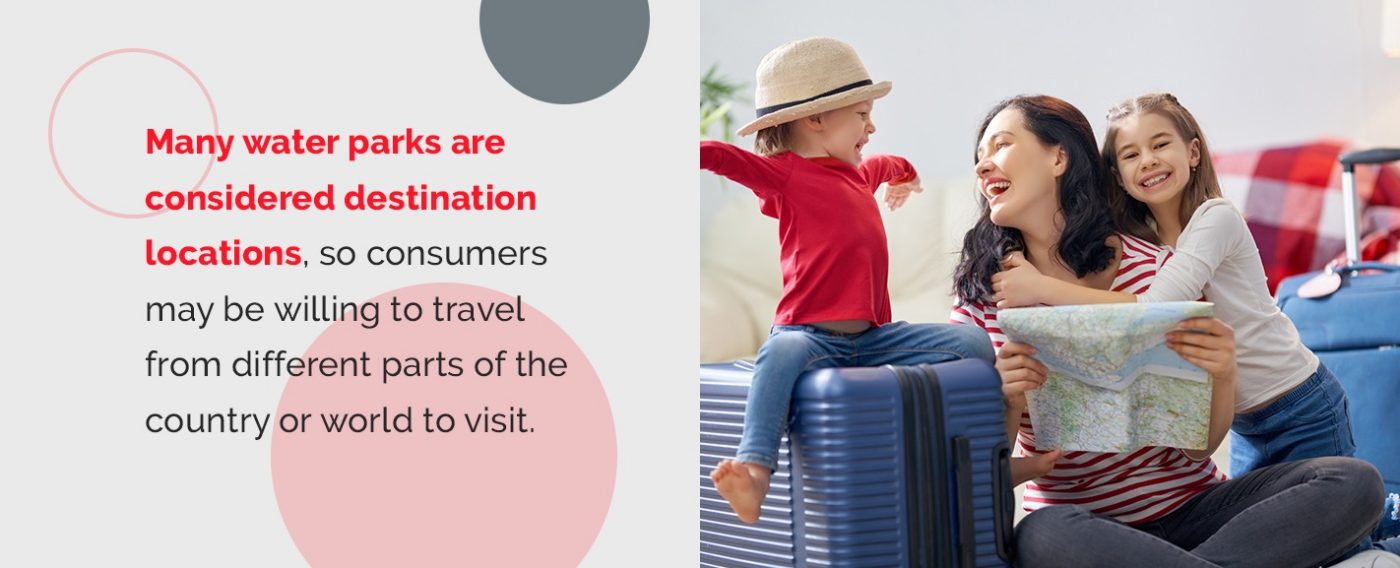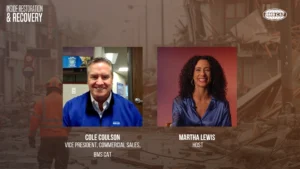What You Need to Know About Starting a Water Park
Water parks are making a splash. Amusement park owners and entrepreneurs are incorporating water parks into their businesses to increase profitability and consumer satisfaction. Included in the water park industry are amusement parks that offer water play areas, such as splash pads, waterslides, lazy rivers, water playgrounds and other swimming activities. Water parks can be located outdoors, indoors or both.
If you’re interested in starting or expanding a water park or own an amusement park area, you probably have questions about how to build a water park, what a water park investment would cost and how you can make this new business profitable. We’ve compiled this guide to help you get started.

Water Parks Growing Profitability
The industry revenue for water parks has increased in the past five years, but what has contributed to this significant growth?
1. WHY IS WATER PARK PROFITABILITY GROWING?
Water park profitability increased due to falling unemployment rates, rising disposable incomes and an improving economy. Consumer spending has been on the rise, which has contributed to the growth of the water park industry.
Consumers are also traveling more, so this may also contribute to the growing profitability of water parks. Many water parks are considered destination locations, so consumers may be willing to travel from different parts of the country or world to visit. How far consumers are willing to travel impacts the profitability of these parks, and consumers’ willingness to travel is affected by several factors, such as fuel prices, geopolitical tension and fear of disease or terrorism.
When the economy is doing well and employment rates are high, Americans have more disposable income to spend on activities like travel and entertainment. Even if geopolitical tension caused consumers to travel internationally less frequently, they would still likely travel domestically often, which bodes well for water parks located in the U.S.
One example of a highly successful water park is Typhoon Texas, which hit attendance capacity and season pass goals faster than anticipated. To increase their profitability, Typhoon Texas made sure to offer activities for all ages.

2. HOW ARE WATER PARKS PROFITABLE?
Many waterparks in America may start small, but entrepreneurs are quickly catching on to the potential for profit through the expansion of a water park. When a water park offers something for everyone and provides its visitors with an enjoyable experience, the park attracts visitors from every corner of the globe. As long as a park is maintained and managed well, there is good potential for growth and success.
So what are the ways water parks are profitable? Water parks make money by charging admission fees, but they also earn revenue through sales of food and beverages, souvenirs and merchandise. Parks may also charge fees for using additional facilities or attractions. By adding a water park to an existing theme park, you can also increase the profits of your theme park, especially during the summer.
Benefits of Adding a Water Park to an Existing Theme Park
Can a water park improve the profitability and enhance the customer satisfaction of an existing theme park? Corporations and theme park owners may initially be skeptical of a water park’s ability to be a profitable investment. They see that water parks have lower attendance than theme parks, so they assume adding a water park to their existing theme park wouldn’t be effective. However, there’s a reason why many theme parks build water parks.
1. WATER PARKS ARE COST-EFFECTIVE
When it comes to cost to build and maintain water park rides versus theme park rides, the costs for a water park are significantly less expensive than the costs for a theme park. A water park can also be built on a smaller plot of land. If you don’t have enough acreage for an additional or expanded theme park, a water park can be an excellent, more affordable alternative.
2. GUESTS WILL EXTEND THEIR VISIT
Visitors to your theme park are drawn in by the promise of a visit with a beloved character or a ride on a record-setting roller coaster, but the inclusion of a water park can entice guests to extend their visit. While you may be able to convince visitors to stay longer with additional theme park rides, a water park can accomplish this much more cost-effectively. The addition of a water park may also help convince locals to buy an annual pass.
By adding a water park to your existing theme park, your guests tend to stay longer and spend more. With the costs for construction and maintenance so much lower than additional theme park attractions, a water park is a highly worthwhile investment for many theme park owners.
Designing a Water Park
After you’ve decided to move forward with building a water park, you’ll need to design it. To determine what you can include in your design, you need to address:
- What your budget is
- What operating costs will be
- What you want to include in the park
- How much land you have
You’ll also want to define what a successful water park is to you. Is your definition of success simply a water park that generates a profit? Or does success mean a water park that earns enough revenue to cover its expenses and future additions or a water park that makes enough to help subsidize other facilities in your park? Your definition of a successful water park will impact the design of the park.
Water parks generally include three aquatic elements — rides, a capacity holder and a children’s area.
1. RIDES
A water park should have rides and attractions that appeal to different age groups. Though most guests want to take a trip down the waterslide, the thrilling attractions for teens won’t be appropriate for young children or older adults who want to enjoy gentler attractions. You can include attractions that anyone can enjoy, but you should also include rides that target certain groups of visitors.
Attractions for infants and toddlers include:
- Gentle spray and water features
- Small, zero-depth pools
- Tot slides
Attractions for young children include:
- Waterslides
- Water sprayground
- Sand play
- Large play structures
- Water walks
Attractions for older children and teens include:
- Large waterslides
- Sand volleyball
- Water walks
- Open water
Attractions for young adults include:
- Intense waterslides
- Open water
- Climbing wall
- Drop slides
- Sand volleyball
Attractions for adults include:
- Open water
- Lap lanes
- Waterslides
- Zero-depth pool
- Spa
- Sun deck
Attractions for older adults:
- Lazy river
- Spa
- Lap lanes
- Family-friendly waterslides
- Sun deck
Rides that accommodate multiple people at once can keep families together, allowing parents to enjoy themselves while also keeping their children at their side.
2. CAPACITY HOLDERS
A capacity holder is an area or attraction that holds many people. Though capacity holders may not make money, they’re key to a water park’s success. A wave pool and a leisure river are both examples of popular capacity holders. They function as the hub of the park, keeping families entertained and having fun without the need to wait in a line.
3. CHILDREN’S AREA
A children’s area is another crucial element to a successful water park. To draw families to your park, you need to accommodate younger visitors. Some of the bigger thrill rides can be too overwhelming for young children, and many parents will want to keep their children with them while at the park. Incorporating large water play structures, children’s pools and spraygrounds can ensure your younger guests can have as much fun as your other guests.
Aside from rides and attractions, you’ll also need to design your park to include facilities and support spaces, such as concessions and restrooms. While the quality of your restrooms won’t draw visitors in, they can ensure that your visitors aren’t driven away. You’ll want to place these spaces according to traffic flow to ensure they enhance your guests’ overall experience in your park.
You should also consider what your plans are for expansion when you’re designing your water park. Regardless of the number of rides you plan on having or the size of the water park, guests enjoy a new attraction being added from time to time. When you’re designing your park, think about where you want to place your first expansion.
Importance of Water Park Equipment
Having the proper water park equipment for bringing customers into the facility is essential. The value and quality of water park equipment can impact the success of your business. For quality equipment, what characteristics should you look for?
- Strong and durable: Your equipment will see a lot of use, so it needs to be up to the task. High-quality equipment that is durable will also mean less maintenance, repairs and replacement, which will save you money.
- Safe: Water park equipment should be designed from materials designed to minimize injuries to keep all visitors safe.
- Professional Installation: Find a manufacturer that is qualified to install water park equipment.
Water Park Equipment From PLAYTIME
At PLAYTIME, we’ve installed unique water park equipment ranging from small areas for kids to elaborate water walk systems across the United States and internationally. Whether you are looking to add on or design a full custom or themed concept for a water park or water play area – we can help from design consultation to installation. Here are just a few of the products we offer for water play areas:
- Splash pads: For a secure, safe space where kids can explore and have fun, consider a zero-depth splash pad. With little to no standing water, splash pads are designed for safety while also giving kids a fun place to play.
- Water slides: With PLAYTIME, you can get a custom-designed water slide to correlate with the grade of your pool. You’ll also find slides equipped with anti-slip surfaces on all transitions.
- Floatables: No matter what the budget or space dimensions you have to work with, PLAYTIME can customize floatables that are perfect for your water park. Choose from 12 themes to create the look that fits best with your water park equipment.
- Climbers and sprayers: Climbers like whales, dragons and frogs create an exciting, aquatic play environment for kids. These climbers can be custom-made and are offered in 12 themes. You can also choose to add sprayers to your climbers for additional water fun.
- Water walk systems: These floating, tethered platforms come in a variety of themes, configurations and sizes to engage kids of all ages. Design a custom water walk system or choose between our Tiki or Tropical pre-engineered packages.









